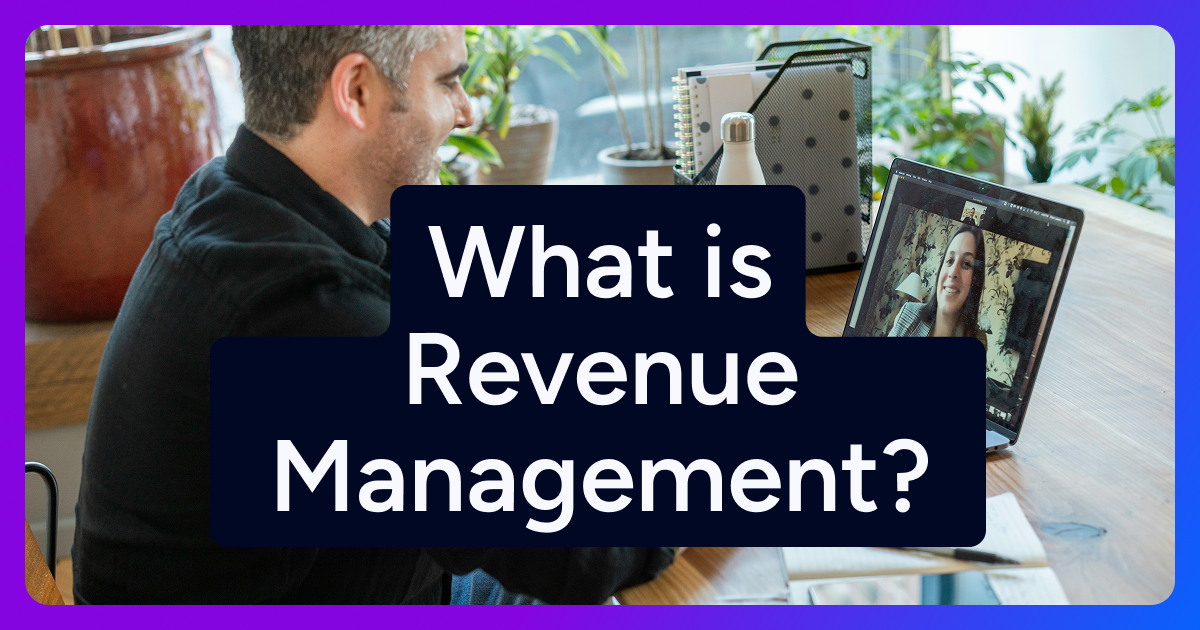Revenue management is the strategic process of maximizing a company’s income by selling the right product to the right customer at the right time, for the right price, through the right channel.
Revenue management involves forecasting demand, analyzing consumer behavior, and dynamically adjusting pricing and inventory to optimize financial performance. It’s commonly used in industries like:
Hospitality
Travel
SaaS
Retail
Successful revenue management hinges on understanding and leveraging strategic approaches to maximizing profitability across a customer’s lifecycle.
Revenue management isn’t just about setting prices. It’s about orchestrating and optimizing every touchpoint from first contact to renewal and beyond.
Why Revenue Management Matters
Successful revenue growth has become increasingly complex. B2B sales cycles are longer, subscription-based pricing models are the norm, and buyer expectations continue to soar. Data-informed revenue management overcomes these challenges by increasing predictability in forecasting, enhancing profitability through optimization, and driving efficiency across sales and marketing efforts.
The companies that are thriving in 2025 are those that are implementing revenue management strategies that give them deeper insights into market trends, customer behavior, and pricing opportunities.
Key Components of Revenue Management
A well-structured revenue management process uses multiple elements to facilitate data-driven decisions that improve company’s bottom line. The most important components of this process are:
Data Collection and Enrichment: The foundation of effective revenue management starts with capturing insights on consumer behavior, maintaining clean customer relationship management (CRM) data, and using tools that provide real-time market intelligence to inform pricing decisions.
Pricing Strategy and Optimization: Taking a scientific approach to setting prices means developing dynamic pricing capabilities that respond to market conditions, creating different prices for different customer segments, and continuously testing to find the optimal pricing structure for your products and services.
Customer Segmentation and Targeting: Separating leads into meaningful customer segments allows for more precise targeting and personalized approaches to each group.
Forecasting and Pipeline Management: Accurate demand forecasting make proactive decisions about resources and inventory. This involves analyzing historical data alongside real-time signals and being ready for multiple forecasted scenarios, not just the most likely.
Contract and Billing Management: Streamlining and, in some cases, automating how contracts are created, executed, and managed can reduce revenue leakage and create flexibility in billing options to accommodate different customer preferences.
Revenue Management Software
While manual revenue management can’t be replaced entirely, revenue management software provides the automation, analytics, and functionality needed to implement financial strategies at scale. The right revenue management system (RMS) gives teams the tools to make informed decisions based on data rather than instinct.
Core Features To Look For
When evaluating the best revenue management platforms, certain features are must-haves:
Automated Revenue Forecasting: Smart forecasting tools can analyze patterns from past performance while incorporating current market conditions to predict future outcomes with significantly greater accuracy than manual methods.
End-to-End Revenue Lifecycle Management: Look for platforms that connect every stage of your revenue process, from initial prospecting through to renewal and expansion, and provide visibility across marketing, sales, customer success, and finance departments.
Pricing and Quoting Capabilities: Configure, Price, and Quote (CPQ) tools can quickly generate accurate quotes, recommend the best product configurations, apply discounts, and help reps present the right value proposition to each prospect, ultimately accelerating the sales cycles.
Real-Time Dashboards and Custom Reporting: The best RMS platforms offer clear visualization of key performance indicators in real time, allowing teams to spot trends, identify issues, and take advantage of timely opportunities.
CRM, ERP, and Billing System Integrations: RMS platforms should integrate with existing tech stacks. Seamless integration ensures data flows freely between departments, eliminating manual data entry, reducing errors, and creating a more complete picture of a business.
Renewal, Expansion, and Churn Management: RMS platforms should highlight at-risk accounts before they churn and automatically identify potential expansion opportunities within your existing customer base.
Advanced Segmentation: Segmentation tools can divide your market not only by static traits such as firmographics, but also by dynamic qualities such as day-to-day user behavior and buyer intent.
Buyer Insights: Customer behavior insights help sellers understand exactly where each account is in their decision process, what content they’re engaging with, and which competitors they might be considering.
Key Revenue Management Metrics and KPIs To Track
Implementing effective revenue management requires careful tracking of specific metrics that indicate performance and highlight areas for improvement. These key performance indicators provide the insights you business leaders need to make adjustments to revenue optimization efforts to ensure they’re delivering the expected ROI.
Metric | Definition | How To Track & Optimize |
Annual Recurring Revenue (ARR) | The total value of recurring revenue and subscription services, normalized to a yearly value. | Track monthly through your billing system. Optimize by focusing on both new customer acquisition and expanding existing accounts through upselling opportunities. |
Average Contract Value (ACV) | The average annual revenue per customer contract. | Calculate by dividing the total contract value by the number of contracts. Increase by improving the value proposition, optimizing pricing tiers, and adding premium features. |
Customer Lifetime Value (CLTV) | The total revenue expected from a customer throughout their entire relationship with your company. | Measure by multiplying average purchase value by purchase frequency and customer lifespan. Improve by increasing retention, raising average order value, and enhancing customer experience. |
Forecast Accuracy | The percent difference between predicted revenue and actual results. | Compare forecasted figures against actual results each period. Enhance by implementing AI-powered forecasting tools and incorporating more data signals into predictions. |
Customer Acquisition Cost (CAC) | The total cost of acquiring a new customer, including marketing and sales expenses. | Calculate by dividing total acquisition costs by the number of new customers in a given period. Reduce by improving targeting precision, optimizing sales processes, and shortening sales cycles. |
Customer Churn and Retention Rate | The percentage of customers who stop doing business with you in a given period. | Track monthly or quarterly through your CRM. Decrease by implementing early warning systems, establishing proactive success programs, and continuously improving value. |
Revenue per Account/Segment | The average revenue generated by accounts within specific customer segments. | Analyze through your CRM or billing system by segment. Maximize by creating segment-specific offerings and implementing tiered pricing strategies aligned with each segment. |
Sales Cycle Length | The average time it takes to convert a lead into a paying customer. | Measure from the first meaningful engagement to the closed deal. Shorten by streamlining sales processes, using intent data to focus on ready-to-buy prospects, and improving sales enablement. |
5 Revenue Management Strategies for Growth
Implementing the right revenue management strategies can dramatically accelerate growth while creating more predictable, sustainable business performance.
1. Use Real-Time Buyer Intent Signals
Use intent data to identify which accounts are actively researching solutions like yours, demonstrating genuine buying behavior, or engaging with competitors.This enables teams to prioritize outreach to the prospects who are most likely to convert.
2. Align GTM Teams Around Revenue Goals
The traditional silos between marketing, sales, and customer success create blind spots that lead to missed opportunities and inconsistent customer experiences. The most successful companies use GTM Intelligence Platforms that break down silos to ensure that the entire go-to-market (GTM) strategy is built on a single source of authoritative truth and aligned to broader objectives.
3. Tiered and Value-Based Pricing Models
Higher prices does not necessarily mean higher revenue, and static pricing models often leave money on the table by failing to capture buyer segments with different needs and budgets. Create a tiered pricing structure that aligns with the specific value your product or service has for different buyer types.
4. Automate Revenue Forecasting With Historical and Behavioral Data
Automated forecasting algorithms can combine historical performance with real-time behavioral patterns, creating models that significantly outperform manual approaches. Use a system that considers factors like deal velocity, engagement data, and customer demand to generate predictions that automatically update as conditions change.
5. Prioritize Upsell and Expansion Revenue
While acquiring new clients can be the top priority for many companies, the real money is with the clients you already have. Existing customers often spend more than new business because they already trust the brand and have positive firsthand experiences with existing products and services. Place special emphasis on identifying expansion opportunities with a revenue management platform that can analyze product usage, identify decision-making leaders, and connect each organization’s growth with their history of using your products or services.
Set the Foundation for Predictable, Scalable Revenue With ZoomInfo
The companies succeeding today are working smarter by implementing revenue operations tools that provide clarity, automation, and intelligence across their entire revenue lifecycle. Whether you’re looking to accelerate growth, increase profitability, or create more predictable performance, revenue management is critical.
And managing revenue effectively starts with transforming your approach to finding, engaging, and growing your most valuable customer relationships. Find out why ZoomInfo is trusted by 35,000+ customers worldwide to provide the Go To Market Intelligence that fuels their revenue engines.
Revenue Management: Frequently Asked Questions
What industries benefit most from revenue management?Revenue management is commonly used in industries with perishable inventory or variable demand, such as hospitality, airlines, car rentals, event ticketing, retail, and SaaS. However, any business aiming to optimize pricing and maximize revenue can benefit.
How does revenue management differ from dynamic pricing?Dynamic pricing is a component of revenue management. While dynamic pricing focuses on adjusting prices in real time based on demand and other factors, revenue management encompasses a broader strategy that includes forecasting, segmentation, inventory control, and distribution.
Do small businesses need revenue management?Yes. While large enterprises may use advanced software, small businesses can apply the same principles, such as tracking demand patterns, adjusting pricing, and managing inventory, to make smarter sales decisions and improve profitability.
What tools or software help with revenue management?Tools including pricing optimization platforms, CRM systems, demand forecasting tools, and analytics software are commonly used in revenue management. AI-powered platforms are increasingly popular for automating and improving revenue strategies.Is revenue management only about maximizing price?No. It’s about maximizing total revenue, not just price. That means balancing pricing with customer lifetime value and market positioning to drive long-term profitability, not just short-term gains.


